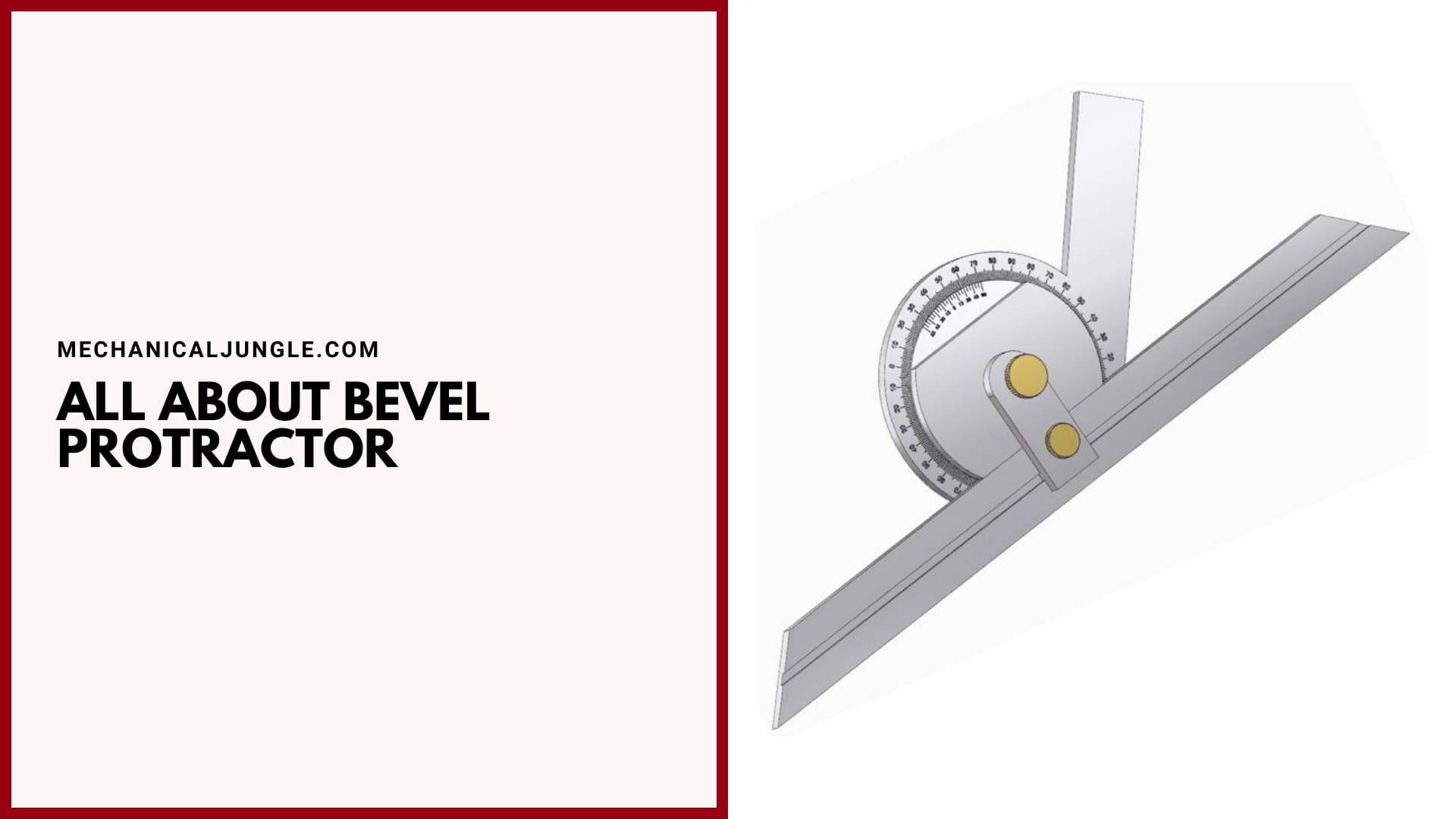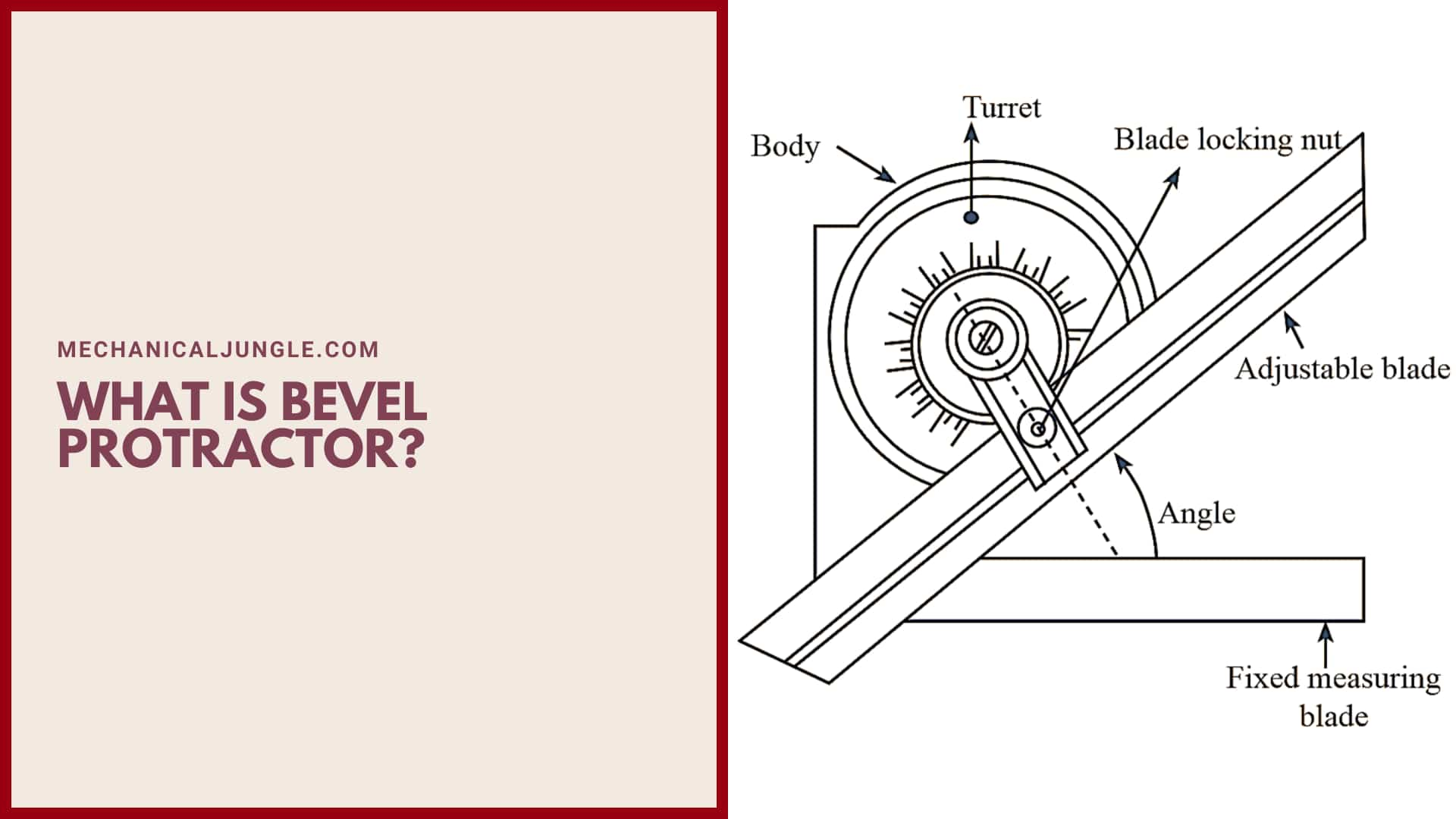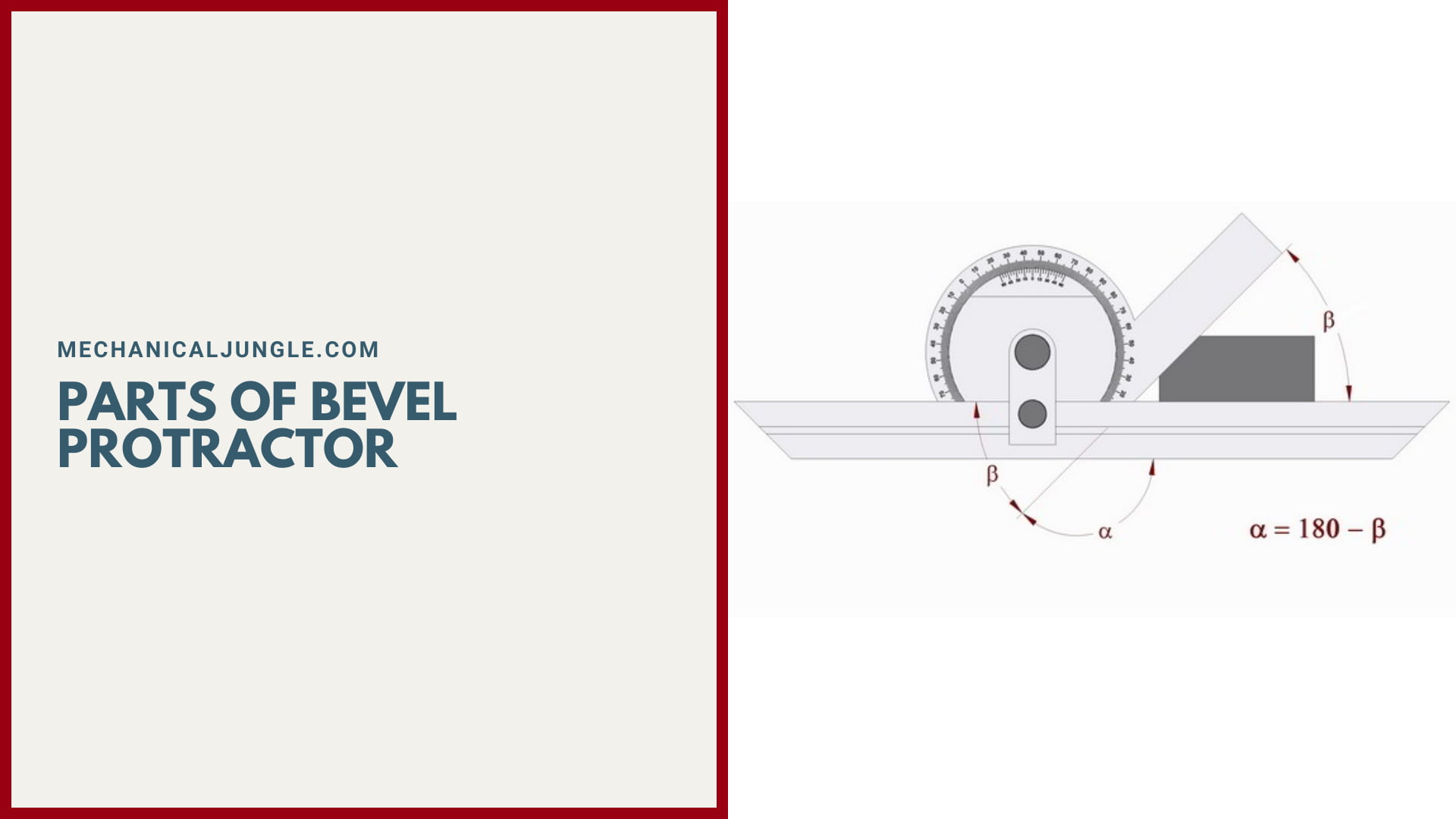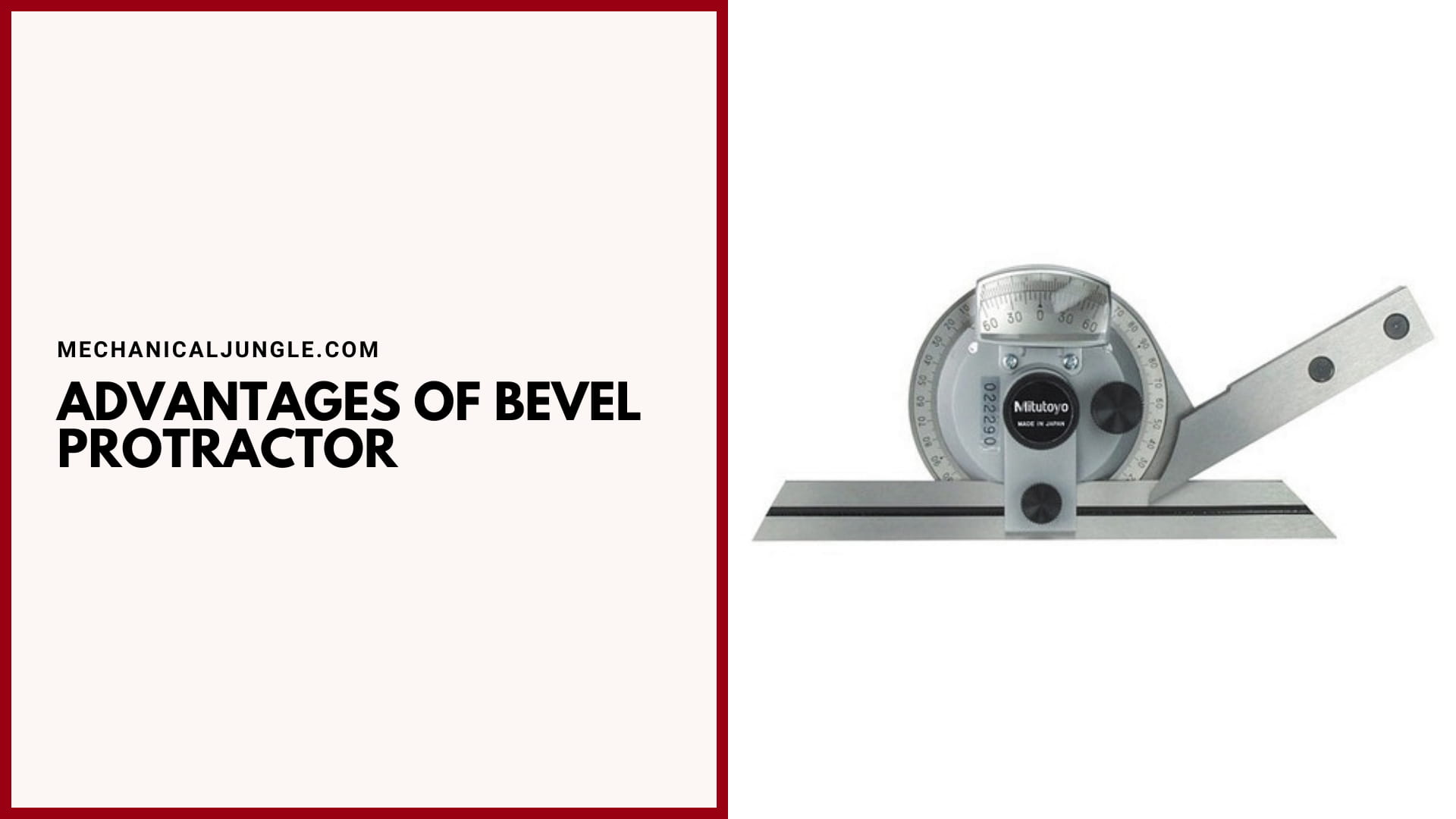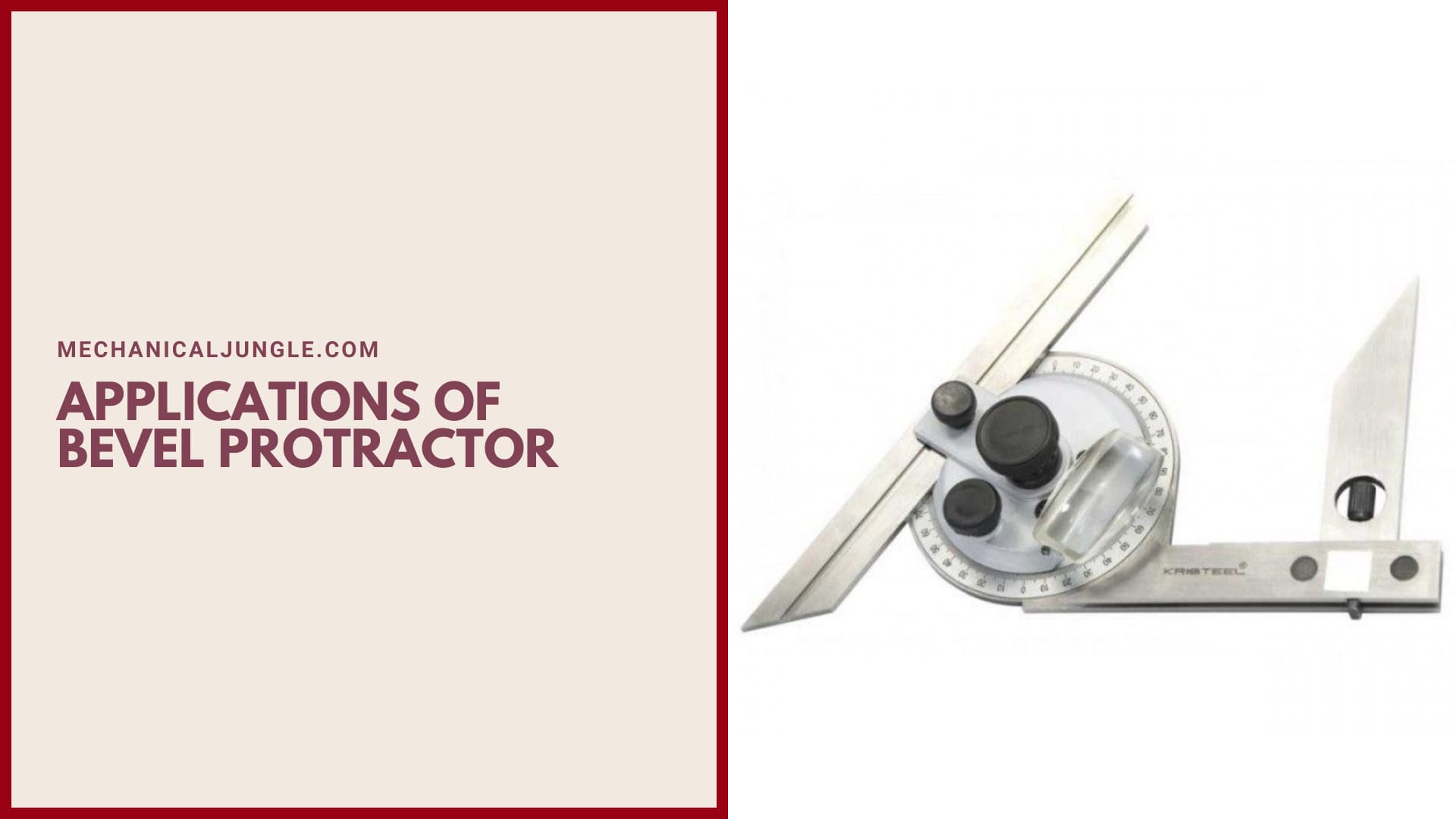Important Point
What Is Bevel Protractor?
A bevel protractor is a device that consists of a graduated circular scale with a pigmented arm used to measure or make angles. In geometry, a protractor is a spherical or semicircular device that is used to measure an angle or circle. The units measured are normally degrees.
Some protractors are half-discs that have existed since ancient times. A more advanced protractor, such as the bevel protractor, is one or two swinging arms, which help measure the angle.
The device is capable of measuring angles with a minimum count of 5′ or 5 minutes. It is used to measure the angles of any workpiece. It is used for various items such as jigs. Sometimes the bevel protractor is attached to the Vernier scale to give more accurate readings.
Bevel protractor has a very important role in mechanical architectural drawing. The use of software such as CAD is reducing the general use of bevel protractors. Bevel protractors are used to test angles. It is used for various mechanical and engineering-related applications.
Parts of Bevel Protractor:
#1. Swivel Plate
The swivel plate rotates on the dial. This swivel plate has a vernier scale that is integrated into it.
#2. Magnifying Glass
A magnifying glass is also present on the version scale in the swivel plate. These magnifying glasses are used to see the value of angles on the main scale and, more clearly, the Vernier scale.
#3. Vernier Scale
The Vernier scales are fixed on the swivel plate, & it moves along the swivel plate. The Vernier scale gives the remaining angle in minutes. There are 60 minutes in 1 degree. It is added to the Vernier scale bevel protractor to increase the accuracy of angle measurement.
In the center, the Vernier scale has a zero. The Vernier scale has 12 partitions on either side of zero, and each division is of 5 minutes. So there’s are 60 minutes on each side of zeros on the Verniers scale.
#4. Angle locking screw
This angle locking screw is used to locks the bevel protractor at a fixed angle so that the locking angle can be measured without any disturbances.
This angle prevents the swivel plate from rotating in relation to the locking screw dial or dial scale.
#5. Dial
This is the basis of the bevel protractor on which the other parts are present. The main scale or dial scale is marked on this dial.
#6. Dial Scale
This dial scale is the core of the bevel protractor. It has a graduated level of angle from a value of 0 degrees to 360 degrees. At this graduation, every tenth degree is counted.
It is divided into four divisions of 360 degrees, every 90 degrees.
#7. Blade
This blade is made of high carbon steel. This blade is a thin blade. These blades are either 150 mm or 300 mm, depending on the bevel’s protractor.
When the blades are parallel to the stock, the zero of the Vernier scale corresponds to the zero of the main scales or the dial scale.
The blade has one end of 45 degrees, and the other has an angle of 30 degrees so that 45 degrees & 30 degrees can be directly measured using these edges.
#8. Blade Lock Screw
Blade locking screws are available to lock the blade at a fixed location. This screw is used when we determine the required length of the blade along the surface of the workpiece.
#9. Stock
The bevel is one of the contact surfaces in the protractor when measuring the stock angle. Stocks are the integrated part of the dial. The dial is also rotated with respect to the blade as it moves, & the angle value changes in the dial scale.
The job or workpieces whose angle is to be measured is placed in contact with this stock on one side. The other side of the job surfaces whose angles are to be measured is placed in contact with the blade. The blade of the bevel protractor goes inside the slot in the stock.
Useful Article for You
Working of Bevel Protractor:
First, the workpiece, whose angles are to be measured, is placed between the blade and the stock of the bevel protractor. One side of the surface measuring the angle is placed in contact with the blade, and the other sides are in contact with the stock.
When the workpiece comes in contact with the blade properly, and the blade is properly placed on the workpiece, the blade is closed using a blade locking screw. After that, when the measured surface comes fully in contact with the stock and blade, the angle is fixed using angle locking screws.
Now we see the values in the main scales, which coincides with the zero of the Vernier scale. The value we read from the main scale gives the angle in degrees. The angle in the main scale, to be more precise, comes just before the zero points of the Vernier scale.
To obtain the angle more accurately, we will now obtain the remaining angle in minutes. To do this, we look at the line of the Vernier scale, which coincides perfectly with the line of the main scale.
After obtaining that line, we see the position of the line in the Vernier scale. Then the minute of the angle measurements is calculated by multiplying the position of the coincident line of the Vernier scale with 5 (five).
Then finally, the angle measured using the bevel protractor is noted in degrees and minutes. Thus, we measure the angle very accurately using a bevel protractor.
Advantages of Bevel Protractor:
Here, the different Advantages of bevel protractor is as follows:
- It can accurately measure angles up to 5 flatter and can measure angles up to 360 degrees.
- It gives very accurate measurements.
- It is used to set up and test to bear angles in very close proximity.
Applications of Bevel Protractor:
Here, the different Applications of bevel protractors are as follows:
- The bevel protractor is used to probe the V block.
- It is used to examine the bevel face inside the ground surface.
- It is also used to measure acute angles.
Also, Read: How to Fix a Leaking Car Roof | Why Water Leaks into Car from its Roof? | Why Is Water Leaking into My Car?
Frequently Asked Questions (FAQ)
Bevel Protractor
Bevel protractors capture angular measurement with an adjustable 360-degree protractor head. A fine-adjustment dial allows for small adjustments in the position of the blades for more accurate readings.
These protractors are compact & offer a high level of precision and accuracy. They are often used in metalworking, machining, & light or heavy manufacturing environments.
Digital Bevel Protractor for Precise Angle Measurement
A digital bevel protractor is a tool used for precise angle measurement in various applications such as woodworking, metalworking, machining, and engineering. It is an advanced version of the traditional bevel protractor, featuring digital technology to provide accurate and easy-to-read angle measurements.
Here are some key features and benefits of a digital bevel protractor:
- Digital Display: Unlike traditional bevel protractors, which rely on a graduated scale and a magnifying glass for reading angles, digital bevel protractors have a built-in digital display. This display shows the measured angle with high precision, making it easier to read and eliminating the possibility of misreading due to human error.
- High Accuracy: Digital bevel protractors are designed to provide precise and accurate angle measurements. They typically have a resolution of up to 0.1 degrees or even finer, allowing for precise adjustments and ensuring accuracy in critical applications.
- Easy Operation: Digital bevel protractors are user-friendly and easy to operate. They usually have simple buttons or controls to turn the device on/off, zero the measurement, or switch between different measurement modes. The digital display makes it straightforward to read the measured angle instantly.
- Hold and Lock Functions: Many digital bevel protractors come with hold and lock functions, which allow you to freeze the displayed angle value. This feature is particularly useful when measuring angles in tight or hard-to-reach areas, as it allows you to take the protractor out of the way while still retaining the measured value for reference.
- Multiple Measurement Units: Depending on the model, digital bevel protractors may offer the ability to measure angles in different units such as degrees, radians, or gradients. This flexibility makes them suitable for various industries and applications that may require different unit systems.
Bevel Protractor Calibration and Usage Guide
Calibration and proper usage of a bevel protractor are essential to ensure accurate angle measurements. Here is a guide that outlines the steps for calibration and provides instructions for using a bevel protractor effectively:
Calibration:
- Check the manufacturer’s instructions: Different bevel protractors may have specific calibration procedures. It’s important to consult the user manual provided by the manufacturer for precise instructions.
- Zero the protractor: Place the bevel protractor on a flat and level surface. Locate the zero adjustment screw or knob on the protractor and turn it until the indicator reads zero on the scale or digital display. This step ensures that the protractor is properly aligned and calibrated.
- Verify accuracy: To verify the accuracy of the bevel protractor, use a reference angle or a known calibrated angle. Place the protractor on the reference angle and compare the reading to the known value. If there is a discrepancy, consult the manufacturer’s instructions on how to adjust or recalibrate the protractor accordingly.
Usage:
- Positioning: Place the bevel protractor on the surface or object whose angle you want to measure. Ensure that the base of the protractor is firmly in contact with the surface, and the measuring arm is aligned with the angle to be measured.
- Read the angle: If using a traditional bevel protractor, locate the zero line or reference point on the graduated scale. The reading is taken from the point where the measuring arm intersects the scale. If using a digital bevel protractor, read the angle directly from the digital display.
- Take multiple measurements: To ensure accuracy, it is recommended to take multiple measurements and average the results. Gently move the bevel protractor along the surface or object while maintaining proper contact to obtain consistent readings.
- Lock or hold the measurement (optional): Some digital bevel protractors have a hold or lock function. If you need to move the protractor away from the measured angle while retaining the value, activate the lock or hold function.
- Convert units (if required): If your bevel protractor allows measuring angles in different units, make sure you set it to the desired unit of measurement (degrees, radians, gradients) before taking the measurement.
Top-Rated Bevel Protractor Brands and Models
There are several top-rated bevel protractor brands and models known for their quality and accuracy. Here are a few popular options:
- Starrett: Starrett is a well-known manufacturer of precision measuring tools, including bevel protractors. Their models, such as the Starrett C434-12-4R Combination Set and the Starrett C493B Protractor, are highly regarded for their durability, accuracy, and ease of use.
- Mitutoyo: Mitutoyo is a reputable brand in the metrology industry, offering a range of high-quality measurement instruments. Their bevel protractors, like the Mitutoyo 187-908 Digital Protractor and the Mitutoyo 187-555 Universal Bevel Protractor, are known for their precision, reliability, and advanced features.
- Brown & Sharpe: Brown & Sharpe is another respected brand that produces reliable measuring tools. Their bevel protractor models, such as the Brown & Sharpe 599-792-20 Digital Protractor and the Brown & Sharpe 599-792-1 Vernier Protractor, are praised for their accuracy and robust construction.
- Fowler: Fowler is a trusted manufacturer of precision measuring instruments, offering various bevel protractor models suitable for different applications. The Fowler 52-439-777-0 Digitronic Protractor and the Fowler 54-565-233 High Precision Protractor are well-regarded for their accuracy, ease of use, and versatility.
- iGaging: iGaging is a brand that provides affordable yet reliable measuring tools. Their bevel protractor models, such as the iGaging 14-019 and the iGaging 14-010, offer good accuracy and ease of use at a more budget-friendly price point.
Bevel Protractor Vs. Angle Gauge: a Comparison
When it comes to measuring angles, both bevel protractors and angle gauges are commonly used tools. Here’s a comparison between the two:
Bevel Protractor:
- Design: A bevel protractor typically consists of a pivoting arm, a protractor head with a graduated scale, and a vernier scale or digital display for precise angle readings.
- Measurement Range: Bevel protractors are designed to measure angles within a specific range, typically up to 360 degrees or 180 degrees. They are suitable for measuring both internal and external angles.
- Versatility: Bevel protractors are versatile tools that can measure angles in various applications, such as woodworking, metalworking, machining, and engineering. They are commonly used in tasks that require manual angle setting and adjustment.
- Accuracy: Bevel protractors can provide accurate angle measurements, especially when using models with high-resolution vernier scales or digital displays. However, the accuracy may vary depending on the quality and calibration of the specific bevel protractor.
Angle Gauge:
- Design: An angle gauge, also known as a digital angle finder or digital protractor, typically features a base and a pivoting arm with a digital display for angle readings. Some models may also have additional features such as a level vial or locking mechanisms.
- Measurement Range: Angle gauges have a wide measurement range, usually from 0 to 360 degrees or even beyond. They can measure both relative angles between two surfaces and absolute angles from a reference surface.
- Digital Accuracy: Angle gauges with digital displays provide precise and accurate angle measurements. They typically have high-resolution sensors that allow for fine measurement increments and often offer features like hold, zeroing, and unit conversion.
- Ease of Use: Angle gauges are often lauded for their user-friendly operation. They are typically compact, handheld devices that can be easily placed and adjusted on various surfaces. The digital display makes it straightforward to read and interpret the angle measurements.
- Specialized Applications: Angle gauges are commonly used in tasks that require precise angle measurements, such as woodworking, carpentry, construction, and metal fabrication. They are especially useful in applications where quick and accurate angle readings are needed, such as miter saw setups or checking the squareness of corners.
Where to Buy a High-Quality Bevel Protractor
You can buy a high-quality bevel protractor from various sources. Here are a few options to consider:
- Specialty Measuring Tool Stores: Look for specialized stores that focus on precision measuring tools. These stores often carry a wide range of bevel protractors from reputable brands. They may have knowledgeable staff who can assist you in selecting the right protractor for your needs.
- Industrial Supply Stores: Industrial supply stores and distributors often stock a variety of measuring tools, including bevel protractors. These stores cater to professionals in fields like machining, metalworking, and engineering. They may carry trusted brands and offer a selection of high-quality bevel protractors.
- Online Retailers: Online marketplaces like Amazon, eBay, and other tool-specific websites provide a convenient way to browse and purchase bevel protractors. These platforms offer a wide range of options from different brands, and you can read customer reviews to gauge the quality and reliability of the products.
- Manufacturer Websites: Visit the official websites of renowned bevel protractor manufacturers. Many manufacturers have their own online stores or provide a list of authorized retailers where you can purchase their products. Buying directly from the manufacturer can ensure authenticity and access to the latest models and accessories.
- Local Hardware Stores: Check with your local hardware stores or home improvement centers. While their selection may be more limited compared to specialized stores, they often carry basic bevel protractor models suitable for general tasks. It’s worth noting that the availability of high-quality options may vary depending on the store.
Vernier Bevel Protractor
A Vernier bevel protractor is a precision measuring tool used for measuring angles with a high degree of accuracy. It is commonly used in metalworking, engineering, and woodworking applications.
Bevel Protector
A bevel protractor is a precision measuring tool used to measure and set angles with a high degree of accuracy. It is commonly used in metalworking, engineering, and woodworking applications where precise angle measurements are required.
Bevel Protractor Is Used For
Bevel protractor is an instrument that we use for measuring the angles of the objects. We see people using it with various objects that include jigs. Whereas, this occurs when we produce engineering/machine drawings. Unlike a normal protractor, we adjust a bevel protractor for fitting an angle.
What Is Bevel Protractor?
A bevel protractor is a graduated circular protractor with one pivoted arm; used for measuring or marking off angles. Sometimes Vernier scales are attached to give more precise readings.
What Is a Bevel Gauge Used For?
A sliding T bevel, also known as a bevel gauge or false square is an adjustable gauge for setting and transferring angles. Different from the square, which is fixed and can only set a 90° angle, the sliding T bevel can set any angle and transfer it on another piece.
Like this post? Share it with your friends!
Suggested Read –
- Adjustable Angle Plate
- What Is a Comparator | Types of Comparators
- Lancashire Boiler | Lancashire Boiler Diagram | Steam Boiler Working Principle | Steam Boiler Parts And Function
- What Is Forming | Types of Forming | Forming Process in Manufacturing | Metal Forming Processes | Forming Operations
- Techniques of Gas Welding | Parts of Welding Torch | Working of Gas Welding | Types of Gas Welding | Types of Flames in Gas Welding
- What Is Sigma Comparator | Construction of Sigma Comparator | Applications of Sigma Comparator | Advantages of Sigma Comparator | Disadvantages of Sigma Comparator
